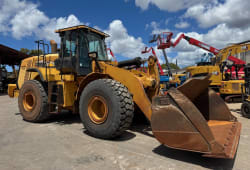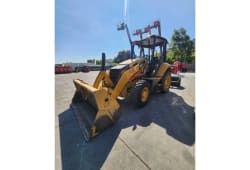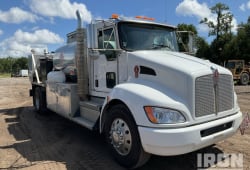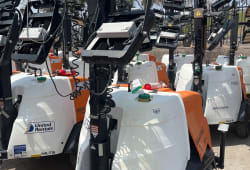Understanding Reduce Vehicle Exhaust Fumes in Heavy Equipment
9 Min read
)
January 6, 2024
In the bustling world of heavy equipment operations, where construction and industrial activities thrive, a significant environmental concern looms large-vehicle exhaust fumes. As powerful machines carry out essential tasks, the emissions they release into the atmosphere contribute to air pollution, impacting both the environment and public health. In this blog, we delve into the imperative of addressing and mitigating vehicle exhaust fumes in heavy equipment.
The issue at hand extends beyond the immediate construction site, with consequences echoing in the broader context of climate change and air quality deterioration. This blog aims to shed light on the multifaceted aspects of the problem, ranging from understanding the composition and environmental consequences of exhaust emissions to exploring the existing regulatory landscape. As the heavy equipment industry faces increasing scrutiny for its environmental impact, this exploration encompasses cutting-edge technological solutions, alternative fuels, and power sources, and best fleet management practices.
Through case studies and industry insights, we'll unravel the success stories of companies adopting sustainable strategies. The challenges inherent in implementing emission reduction measures will also be addressed, offering a comprehensive overview of the industry's current stance and its trajectory towards a more environmentally conscious future. Join us on this journey as we navigate through the complexities of reducing vehicle fumes in heavy equipment, emphasizing the crucial role the industry plays in shaping a sustainable tomorrow.
Understanding the Problem
In the intricate tapestry of heavy equipment operations, a critical concern emerges-vehicle exhaust emissions. This section serves as our gateway to comprehending the intricacies of the problem, starting with an exploration of the composition of these emissions. We delve into the cocktail of pollutants released into the air by heavy equipment, understanding the specific elements that contribute to environmental degradation.
Nitrogen oxides to particulate matter, we dissect the common pollutants emitted during heavy equipment operations, providing a nuanced understanding of their origin and potential impact. As we unravel this chemical symphony, the environmental consequences come sharply into focus. The negative effects extend beyond the immediate construction site, permeating the air we breathe and influencing ecosystems.
This exploration aims to connect the dots between heavy equipment operations and the broader environmental implications, emphasizing the importance of addressing and mitigating these emissions. By dissecting the components of vehicle exhaust and elucidating their consequences, we pave the way for informed discussions on effective strategies and solutions to minimize the environmental footprint of heavy equipment activities. Join us in this journey of unraveling the layers of understanding surrounding the intricate problem of vehicle exhaust emissions in the realm of heavy equipment.
Regulatory Landscape
As we navigate the complex terrain of heavy equipment operations and their environmental impact, this section casts a spotlight on the regulatory landscape governing vehicle emissions. An essential aspect of addressing the problem of lies in understanding and complying with existing regulations. We begin with an overview of the current standards and guidelines that govern vehicle emissions in the heavy equipment industry.
Exploring the intricacies of these regulations, we shed light on the specific benchmarks and criteria set by authorities to control and reduce exhaust emissions. This comprehensive understanding is crucial for industry stakeholders, providing a roadmap for compliance and environmentally responsible practices. The role of compliance becomes a linchpin in our discussion, elucidating how adherence to regulations serves as a cornerstone for achieving environmental sustainability.
By delving into the regulatory landscape, we aim to empower readers with knowledge about the existing frameworks that guide the industry's environmental practices. From emission limits to testing procedures, this exploration sets the stage for informed discussions on the role of regulatory compliance in mitigating the environmental impact of heavy equipment. Join us as we unravel the layers of regulatory intricacies shaping the path toward a more sustainable future in the heavy equipment sector.
Technological Solutions
In the realm of heavy equipment emissions, technological innovation stands as a beacon of hope for a cleaner and more sustainable future. This section introduces readers to cutting-edge emission control technologies that have emerged as powerful tools in the battle against exhaust fumes. We delve into advancements like diesel particulate filters (DPF), selective catalytic reduction (SCR), and exhaust gas recirculation (EGR).
Each technology is dissected to unveil its inner workings and how it contributes to curbing specific pollutants released during heavy equipment operations. From trapping particulate matter to chemically transforming nitrogen oxides, these solutions play a pivotal role in reshaping the emissions landscape. However, with innovation come nuanced considerations. This section meticulously evaluates the benefits and limitations of each technology, providing a balanced perspective on their effectiveness in reducing exhaust emissions.
Our exploration aims to equip readers with a comprehensive understanding of the arsenal of emission control technologies available. By unraveling the intricacies of these advancements, we pave the way for informed decision-making, fostering a dialogue on the practical implementation of these technologies in the heavy equipment industry. Join us as we navigate the forefront of technological solutions, exploring their potential to transform heavy equipment operations into more environmentally conscious endeavors.
Alternative Fuels and Power Sources
In the pursuit of sustainable heavy equipment operations, this section propels us into the realm of alternative fuels and power sources. We embark on a journey through various eco-friendly options, such as biodiesel, compressed natural gas (CNG), and electric power, designed to revolutionize the way heavy equipment is fueled.
Delving into each alternative fuel, we uncover the unique characteristics that differentiate them from traditional fossil fuels. From the renewable nature of biodiesel to the clean combustion of compressed natural gas and the electrifying potential of electric power, these alternatives offer a diverse range of solutions. As we explore the benefits of each, we also confront the challenges inherent in their adoption, acknowledging the complexities of transitioning from conventional fuel sources.
Our examination extends beyond mere fuel options, considering the broader implications of these alternatives on the environment and operational feasibility. By critically evaluating the benefits and challenges associated with alternative fuels, we strive to illuminate the path toward a greener, more sustainable future for heavy equipment. Join us in this exploration of innovative energy solutions that hold the promise of transforming the heavy equipment industry into a beacon of environmental responsibility.
Challenges and Future Outlook
As we navigate the complex landscape of reducing vehicle fumes in heavy equipment, it's crucial to confront the challenges that hinder seamless implementation. This section candidly addresses the hurdles faced in deploying effective emission reduction strategies within the heavy equipment sector.
We delve into the intricacies of regulatory, technological, and operational challenges that stakeholders encounter on their journey toward cleaner emissions. By acknowledging these hurdles, we pave the way for constructive dialogue and strategic planning to overcome impediments.
Moreover, our exploration extends to the horizon of possibilities, discussing ongoing research initiatives and potential future developments in emission reduction technologies. We aim to provide readers with a glimpse into the innovative strides being made to overcome current challenges and propel the heavy equipment industry toward a more sustainable and environmentally conscious future.
Join us in this section as we confront the present challenges head-on while keeping an optimistic eye on the evolving landscape of emission reduction technologies. By understanding the current scenario and envisioning future possibilities, we collectively contribute to shaping a cleaner, greener future for the heavy equipment sector.
Challenges and Future Outlook
The journey toward reducing vehicle exhaust fumes in the heavy equipment sector is not without its hurdles. This section navigates through the challenges encountered in implementing effective emission reduction strategies within the industry.
1. Technological Transition: The adoption of advanced emission reduction technologies presents a transitional challenge. Integrating new systems into existing heavy equipment fleets requires significant investment and adjustments.
2. Operational Disruptions: Implementing emission reduction measures may lead to temporary operational disruptions. Industries reliant on heavy equipment must balance the need for reduced emissions with maintaining productivity.
3. Cost Implications: The financial aspect remains a significant hurdle. The upfront costs associated with acquiring and implementing advanced technologies can be prohibitive for some businesses, especially smaller enterprises.
4. Regulatory Compliance: Adhering to evolving emission standards can pose challenges, particularly for businesses with outdated equipment. Meeting compliance may necessitate substantial retrofitting or replacements.
Future Outlook
1. Research Initiatives: Ongoing research endeavors focus on overcoming current challenges. Scientists and engineers are exploring innovative solutions to enhance the efficiency and affordability of emission-reduction technologies.
2. Advanced Materials: The development of advanced materials, catalysts, and components is a key area of exploration. These materials aim to improve the durability and cost-effectiveness of emission control systems.
3. Intelligent Integration: Future developments envision the intelligent integration of emission reduction technologies. Smart systems that adapt to varying operational conditions, optimizing efficiency while minimizing environmental impact, are on the horizon.
4. Collaborative Initiatives: The future outlook emphasizes collaborative efforts among industry stakeholders, researchers, and policymakers. By fostering synergy, the heavy equipment sector can collectively overcome challenges and accelerate the adoption of sustainable practices.
In this section, we confront the complexities and uncertainties on the path to emission reduction. Simultaneously, we look ahead with optimism, recognizing the potential for groundbreaking innovations that will reshape the landscape of heavy equipment emissions in the years to come.
Conclusion
In drawing the curtains on our exploration into the imperative realm of reducing vehicle exhaust fumes in heavy equipment, let's reflect on the pivotal takeaways that underscore the significance of this endeavor.
Through the preceding sections, we've unraveled the complexities surrounding vehicle emissions, probing into the environmental consequences, regulatory landscape, technological solutions, alternative fuels, challenges, and the promising outlook for the future. The urgency of addressing this issue echoes through the interconnected web of ecological impact, regulatory imperatives, and the transformative potential of innovative technologies.
Let this conclusion resonate as a clarion call for proactive engagement, collaborative efforts, and an unwavering commitment to reducing vehicle exhaust fumes in heavy equipment. Together, we have the power to steer the heavy equipment industry toward a greener horizon, where innovation and environmental stewardship go hand in hand.

Caleb Woods is an experienced content specialist and an editor at Boom & Bucket, blending his journalism background with expertise in the heavy equipment industry. He delivers engaging, informative content to help professionals stay informed and make smarter decisions in the machinery market.














